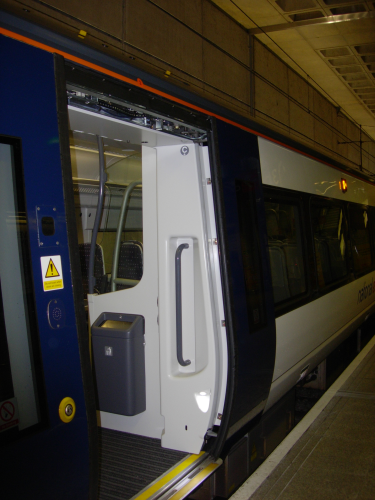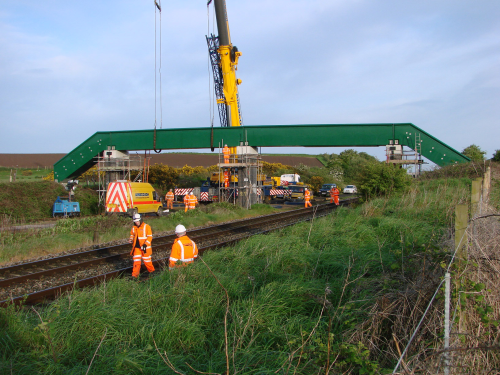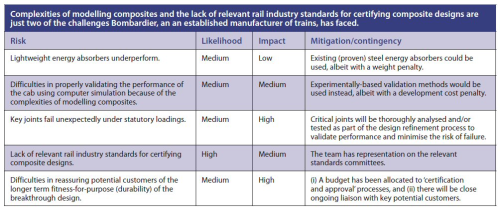


FRPs offer designers of trains opportunities for lightweighting, geometrical complexity, crashworthiness, and design integration. In infrastructure, FRPs offer the advantage of offsite modular construction, thereby minimising disruption to passengers and operators, as well as enhanced durability.
| Rail engineers often say that the extra weight in most metals is essential to keep trains on tracks. This means that the composites industry needs to make a case based on the greater efficiency of using composites and to demonstrate how they can be used alongside metals. |
Designers, fabricators and polymer producers who want to supply the rail industry face numerous challenges. Perhaps the most often heard objection to the greater use of polymer composites in trains and railways is that they are too light. Rail engineers often say that the extra weight in most metals is essential to keep trains on tracks. This means that the composites industry needs to make a case based on the greater efficiency of using composites and to demonstrate how they can be used alongside metals.
Another obstacle is the conservative approach of rail engineers. Designers, fabricators and polymer producers can overcome this by working together to respond to objections about using composites.
Standards
Standards are another challenge. This hurdle is being overcome by the harmonisation of standards in areas such as fire retardancy. The next European fire and fumes regulation for rail vehicles is EN (European Standard) 45545. It is currently at a Technical Specification (TS) stage and is expected to become an EN standard by the end of 2012 or early 2013.
At a NetComposites rail industry event held in Derby, UK, in October 2012, CCP Composites presented its Fireblock series of non halogenated, fire-retardant resins and gel-coats. These intumescent materials are designed to swell and produce an oxygen-blocking char layer on the composite’s surface when exposed to flame/heat. The aim is that the low density and poor thermal conduction of the char protects the underlying material from damage with continued heat or flame exposure.
The product is currently being used in many mass-transit projects, including Carlson buses and the new Bombardier Innovia Monorail 300 system in São Paulo, Brazil.
Fire performance standards are being harmonised but this issue needs to be constantly reviewed in other areas such as component design and parts testing. It is important to maintain the momentum if customers’ requirements are to be realised, in particular the trend towards developing trains largely made from composites which can run on a pan-Europe rail network.
Reluctance to embrace composites
Too often, as delegates in Derby heard, composites are still seen as new materials. This is despite the fact that they have been used in railways for over 30 years. Their use has ranged from luggage racks to driver’s cabs, and station platforms to footbridges. The composites industry is working on those issues but the reluctance to enthusiastically embrace polymer composites is perhaps the most frustrating current barrier.
Professor John Roberts, Manager, Mainline Product Assurance & CoC Authorisation, Bombardier Transportation UK, considered some of those issues in his presentation. He said that the original brief, which was supplied in November 2006, was to produce a lightweight variant of the cab for Bombardier’s new Ile-de-France (IDF) vehicle. It is called NAT/SPACIUM and is the regional train which operates in the suburbs of Paris.
The set objectives were that the new cab must be 40% lighter, require 75% fewer parts, and be 20% less costly than the cabs on existing suburban trains in Paris.
The aim was to meet the primary existing requirements of the IDF specification whilst also realising the above improvements. The technologies developed had to be broadly applicable to a wide range of vehicle types. The work was undertaken as part of the DE-LIGHT Transport European Project.
| The new cab was a three-stage modular construction to facilitate inspection, maintenance, repair and replacement with lightweight energy absorbers. Steel structural members were replaced with a lightweight composite sandwich construction. |
By June 2010 a concept had been defined, detailed and prototyped. The new cab was a three-stage modular construction to facilitate inspection, maintenance, repair and replacement with lightweight energy absorbers. Steel structural members were replaced with a lightweight composite sandwich construction. The main structural element was validated through experimental testing.
Partial validation of main energy absorbing devices was done using non-linear finite element simulation. This involved the preparation of a computer aided design (CAD) model; 1/20th and 1/8th scale models; a full set of manufacturing drawings; a full-scale prototype; and a report on the development.
One of the issues, which Bombardier is addressing, is the lack of relevant rail industry standards for composite designs. However this was not a problem for Umeco. It supplied phenolic prepreg for standbacks manufactured by Ipeco Composites for Bombardier Transportation’s Class 379 Electrostar EMU Passenger Trains, operated by National Express on its Stansted Airport rail link (since February 2012 the Stansted Express has been operated by Greater Anglia).
Ipeco Composites manufactured 960 standbacks for Bombardier using Umeco’s MTM®82S-C phenolic prepreg which meets the requirements of BS 6853 Cat.1a, the standard governing the fire performance of rail rolling stock.
According to Umeco, Ipeco, one of its customers, has a history of manufacturing phenolic prepreg structures for the aircraft industry and it was a natural progression for the company to extend its expertise to the railway industry.
“All units passed effortlessly through Bombardier Transportation’s rigorous quality approval process,” claims Umeco, “a key factor being the superior dimensional tolerances prepreg moulding offers in comparison to wet lay-up processes. The autoclaved MTM82S-C standbacks were installed by Bombardier without rework, thus reducing onsite labour costs and so contributing to the quality and timely delivery of this fleet of trains.”
NPSP, a Dutch company, says it has also demonstrated why composites are the ideal materials to make train components.
Composite nose plates
According to Willem Bottger, Director of Innovation, NPSP NedTrains’ (Dutch Railways)’ trains “used to have a back and front nose with two doors through which passengers could move from one part to the other while the train was moving. The doors however were failing more and more when coupling trains. Besides this passengers did not like going through the narrow corridor when moving from one part to the other.”
Together with the engineering department of NedTrain, NPSP Composites developed a high quality, reliable, very light double bended sandwich composite front and back panel that fulfilled all technical requirements and saved a lot of energy by being so light.
According to NPSP, NedTrain’s engineering department decided to re-engineer the front plate and to move to the new composite material. Together with the dedicated NPSP team new front panels were developed. Strength, stiffness and impact resistance were optimised as well as fire resistance. Before production started the elements have been tested extensively in Austria.
DSM Resins, Euroresins and Alcan Airex advised on which materials should be used to fulfil the physical properties in combination with the vacuum assisted resin transfer moulding (VA-RTM) production process. Airborne Composites helped with the engineering part. 3M developed the special foil which has been used instead of environmentally unfriendly spray painting methods.
The new nose plates were made using glass fibre and foam, making them lighter and cheaper than the old steel noses. NPSP claims that the design and production technique has lowered installation costs, energy use, carbon dioxide (CO2) emissions and maintenance. The attachment points were incorporated at the moulding stage to guarantee the tolerances on the connections.
NPSP adds: “As well as being strong and rigid, the new nose plates can withstand all weather conditions. It was possible to produce several plates at one time, using several moulds.”
NPSP produced the panels with the VA-RTM process. This production technique also gives the opportunity to integrate metal inserts in the one shot production step. Each panel was 2 m x 1.5 m with a thickness of 80 mm.
Cork core?
Mäder Composites, based in Switzerland, also claims to have demonstrated why composites should be more widely used in European trains. It was a member of EcoTrain, an R&D project that uses cork as a core material for railway interior components, floor and sidewall panels.
Funded by the European Regional Development Fund (ERDF) under COMPETE - Operational Programme for Competitiveness Factors, this project aims to develop solutions that make next-generation trains more eco-efficient, lighter and more comfortable. Floors, partition walls and side panels are some possible places where cork may be used. The use of this sustainable raw material in the rail industry is expected to achieve many strategic objectives including a reduction in CO2 emissions, a reduction in fossil fuel usage, and compliance with the new European regulatory framework for the rail industry (CEN 45545).
According to Mäder Composites, the Lightweight Composite Concept UP-Window Frame made with cork core has these advantages compared to standard GRP:
- passes fire, smoke and toxicity railway standards NF F16-101 (M1F2) and EN 45545-2 HL2 (coloured gel-coat);
- 30% weight reduction;
- increased thermal and acoustic insulation;
- 20% reduction in environmental impact; and
- lower material cost. ♦
Part 2 of this feature will look at the use of composites in rail infrastructure such as bridges. It will be available online soon.
This article was also published in the November/December 2012 issue of Reinforced Plastics magazine.
The digital edition of Reinforced Plastics is distributed free of charge to readers who meet our qualifying criteria. You can apply to receive your free copy by completing the registration form.
Also see:
- Can trains be half plastic? Part 1 and Part 2. Today’s rail vehicles use composites widely in their interiors, but exteriors are still mainly metal. The latest aircraft, however, are 50% composite – including their load-bearing primary structures. This article asks why this is, and looks at the use of composites in rail interiors and exteriors.






